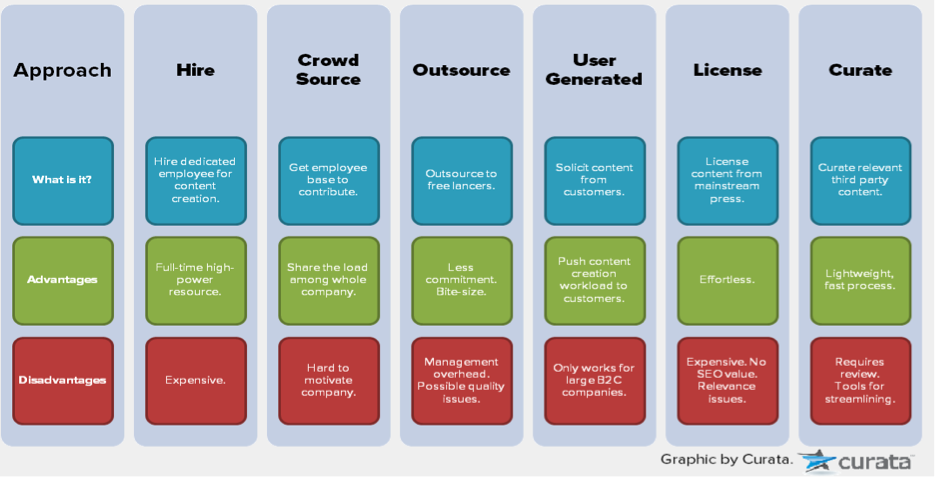- Share The Only 6 Ways to Build a Sustainable Content Marketing Organization on Facebook
- Share The Only 6 Ways to Build a Sustainable Content Marketing Organization on Twitter
- Share The Only 6 Ways to Build a Sustainable Content Marketing Organization on Linkedin
- Share The Only 6 Ways to Build a Sustainable Content Marketing Organization via email
Year after year, survey after survey, the greatest challenge facing marketers interested in content marketing is producing sufficient quality content. Last year, the Content Marketing Institute and MarketingProfs ran a joint survey showing that the producing content was the greatest challenge facing marketers (64% of respondents). Similarly, last year, at Curata, we ran a B2B Marketing Trends Survey and found that the single greatest challenge was creating sufficient original content at 69%.
Even anecdotally, if you have attempted content marketing, you have likely faced this challenge yourself. Most organizations are quick to start a new blog, and create an introductory post, followed by a few other introductory thought leadership posts, before letting it languish. Though we all know content marketing works when it’s done right, few of us, are able to pull it off.
The Only 6 Ways to Build a Sustainable Content Marketing Organization
But some organizations are able to reliably produce sufficient content on a regular basis and feed the content beast. There’s only six possible ways to do this. Here’s an overview along with the tools to use and the pitfalls to avoid.
Hire a Dedicated Content Creator
One way to get a content marketing program working for the long term is to hire a full-time dedicated resource for creating content on a regular basis. This person’s job is solely to create content on a regular basis. While much of the unique thought leadership content about your industry will emanate from senior employees in your organization, this person can add tremendous value in terms of repurposing that thought leadership content in the form of bylines, or creating best practices and tips content on a regular basis.
The downside is that this is will set you back somewhere between $30K and $60K a year depending on the level of experience. You will also have to dedicate some significant time towards coaching this person to create content from your organization’s perspective and voice before they are self-sufficient. The cost alone is prohibitive enough for many organizations to avoid pursuing this approach.
The pitfall for many companies is that they attempt to assign these responsibilities to an existing marketing team member without lessening additional responsibilities for that individual. In such cases, the content creation usually takes backseat to less time-sensitive activities and does not get created on a regular basis.
Crowd Source Internally
Many novice content marketers hope that other parts of the organization will pitch in and create content from time to time. If everyone could write one blog post a quarter, wouldn’t our company have a vibrant blog representing diverse point of views? One big advantage of this approach is that you get content from parts of the organization who are very closely to the industry and customers (such as from the customer service, the CTO, and the sales team).
Coordinating content creation among such a large contributor base is challenging. Luckily there are dedicated content marketing tools to help organize and maintain a content production schedule and workflow process using an editorial calendar.
The problem with this thought process is that other than marketing, no other part of the organization will prioritize content above their other existing responsibilities. Even if you give prizes, and perks to other employees for creating content, most organizations are unable to pull this off. As a result, the crowd-sourced approach almost always fails at first.
Outsource Externally
The third way to produce content day in and day out is to outsource outside of your organization. Under such services, you can post assignments to a marketplace of writers who can bid for the assignment. Outsourcing content creation is not expensive unlike hiring a full time in house content writer, and it’s something you can try out with little commitment.
If you are looking for a retained relationship, there are content marketing writing agencies like that can help out. Or if you prefer a per assignment relationship with a broader choice of writers, you try service market places such as Scripted.
The disadvantage to such services is that the quality of work can sometimes be an issue. You often don’t know the writer you are working with, and they in turn don’t know your company and industry well. However, similar to software outsourcing, if you are willing to dedicate time towards flushing out thorough requirements, it can work well.
Collect User Generated Content
Another option is to collect content from your audience through user generated content (UGC). UGC is a popular mechanism for well known B2C brands to build content communities by soliciting stories relating to the brand from a happy customer base. As an example, Washington-based insurance company, Pemco, does this on their blog.
If you can pull this off, then it’s a big win. But unfortunately, most B2B companies lack large vocal and passionate user bases who will take time to create meaningful content. Instead, B2B companies can conduct regular interviews with select customers, and publish case studies, but it’s still too much work to become a mainstay of their content marketing strategy.
License Content
If you have the budget, another option is to license content from media outlets that you can syndicate on your site and blog. It’s an attractive option for organizations that are short on time, but not on funds, and need something immediate to engage their audience.
But there are several downsides to licensed content to be aware of aside from cost. Licensed content can’t be indexed by search engines, and must be published as is giving you no room for adding your brand’s point of view. Lastly, while it’s easy to license content for mainstream topics, it’s difficult to find very relevant content from nice publications that are relevant to your business.
Curate Other People’s Content
If you can’t get budget for hiring a dedicated internal resource, can’t motivate your co-workers to create content, don’t have a user base as a content source, are wary of licensing content, and don’t want to manage an outsourced content team, then content curation may be for you. As a content curator, you can publish sufficient content for your content marketing campaigns, by selectively finding, organizing and sharing the best content on your topic. Unlike licensed content where you publish the full text, here you only share a small excerpt from the original text along with your commentary and link back to the original.
The downside of content curation is that it is fundamentally a human process and is not completely automated. You do have to take time to find interesting content, editorialize it and then publish it. While you simplify this process by duct taping together Google Alerts, feed readers, and a half dozen other tools to form a rudimentary curation process, there are also content curation tools like Curata that make it a seamless process that can be perform in a little as 20 minutes a day.
In Summary
Here’s a quick summary of the different approaches and what to look out for.

If you are looking to just get started or dive deeper into these approaches, a good starter guide is the How the Feed the Content Beast eBook with a foreword by Ann Handley (author of Content Rules).








